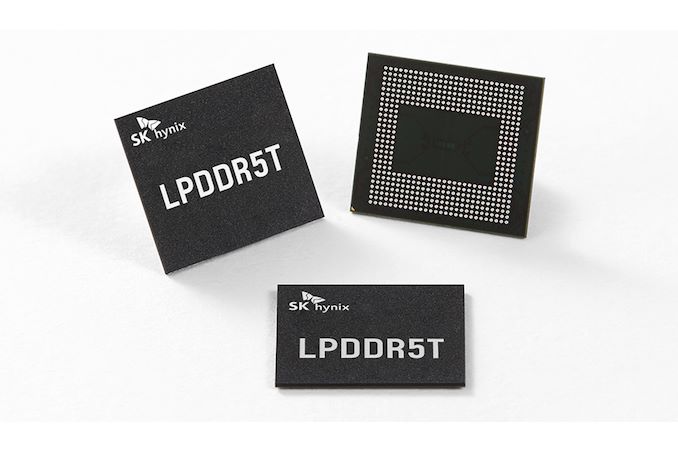SK hynix Ships LPDDR5T: 9600 MT/s Memory for Smartphones
by Anton Shilov on November 14, 2023 3:30 PM EST- Posted in
- Memory
- Smartphones
- SK Hynix
- LPDDR5X
- LPDDR5T

SK hynix had started volume shipments of its LPDDR5T-9600 memory for high-end smartphones, the company announced this week. So far, the company's LPDDR6 'Turbo' memory with a 9600 MT/s data transfer speed has been certified to work with two range-topping mobile application processors from Qualcomm and MediaTek.
SK hynix's LPDDR5T-9600 memory is available in 16 GB packages with a VDD voltage range of 1.01V to 1.12V and a VDDQ of 0.5v. Notably, this VDD range is just slightly over the LPDDR5X specfication (1.00V to 1.1V), which shouldn't be a serious problem, but likely warrants some extra compatibility testing with existing chips.
Smartphone and SoC manufacturers have a great incentive to validate SK hynix's LPDDR5T-9600 and Micron's LPDDR5X-9600 memory as these modules offer a 76.8 GB/s peak bandwidth, up 12.5% from 68.2 GB/s offered by LPDDR5X-8533.
So far, SK Hynix's LPDDR6T-9600 modules have been certified by Qualcomm for its Snapdragon 8 Gen 3 mobile SoC as well as MediaTek for its Dimensity 9300 and some subsequent processors. Meanwhile, SK Hynix confirmed that it had begun shipments of its LPDDR6T-9600 devices to Vivo, which will use it for X100 and X100 Pro mobile application processors.
Following the latest trends, SK hynix mentions that its very fast LPDDR5T-9600 memory will be particularly useful for on-device AI applications. And, of course, faster DRAM is always welcomed for graphics intensive mobile applications, such as games.
"Smartphones are becoming essential devices for implementing on-device AI technology as the AI era kicks into full swing," said Myoungsoo Park, Vice President and Head of DRAM Marketing at SK hynix. "There is a growing demand for high-performing, high-capacity mobile DRAMs in the market. We will continue to lead the premium DRAM market based on our technological leadership in AI memories, while staying in tune with market demands."
Source: SK Hynix










17 Comments
View All Comments
NextGen_Gamer - Tuesday, November 14, 2023 - link
I would love for AnandTech to do a good old fashion mobile SoC faceoff, with a top-tier phone using the Dimensity 9300, Snapdragon 8 Gen 3, and Apple's iPhone 15 Pro and its A17 Pro chip.PeachNCream - Tuesday, November 14, 2023 - link
Feb 2022 was the last time I was able to find an AT article that included phone benchmarks.https://www.anandtech.com/show/17246/handson-with-...
Not sure they still do that sort of thing for the handset market anymore.
Ryan Smith - Wednesday, November 15, 2023 - link
Right now we do not (as much as I'd like to be).mode_13h - Thursday, November 16, 2023 - link
When I clicked this article, I was hoping to see a breakdown of what differentiated it from LPDDR5X, similar to how this article on LPDDR5X explained how it differed from regular LPDDR5.https://www.anandtech.com/show/16851/jedec-announc...
I suppose you can understand my disappointment.
wrosecrans - Wednesday, November 15, 2023 - link
Every once in a while somebody reinvents the idea of using your phone as a desktop that you dock and plug it into a big monitor and run big desktop apps. But that has never actually caught on. And honestly, I don't really care about the performance of the apps I do run on my phone in the real world on a tiny screen. Or to the extent that I do care, crappy developers manage to take in increments of 10x of what a new SoC can bring in increments of 10%.I'm the kind of person who hangs around reading Anandtech articles about chips all day, and I genuinely have no idea what SoC is in my current phone. My life wouldn't be made any better if it was 2x the speed. There was a "good enough" inflection point a few years back, and it all just seems like marketing puffery with no real benefit at this point. Which is part of the reason general purpose technologies like faster RAM all talk about AI as if cranking up a clock speed was somehow specific to AI. It's just generally chasing a buzzy trend, and not tied to anything end users are actually doing.
NextGen_Gamer - Tuesday, November 14, 2023 - link
Oh, according to Vivo's own China product page for the X100 Pro, the 12GB/256GB, 16GB/256GB and 16GB/512GB options are all using LPDDR5X memory. Only the highest-end, 16GB RAM + 1TB storage option is outfitted with LPDDR5T memory.mastomi - Tuesday, November 14, 2023 - link
imagine 8 core zen5c with 680m with this on package like apple m series. it would be nice upgrade for steam deckET - Wednesday, November 15, 2023 - link
I see a lot of Steam Deck wishes for 8 core CPUs, and I have no idea why. I think it's a total waste of silicon in a device that is extremely GPU bound. 4 cores should be enough.But on the point of this article, yes, handheld gaming PCs will certainly benefit from higher RAM bandwidth.
nandnandnand - Wednesday, November 15, 2023 - link
The 8-core is the unit of gaming for the foreseeable future, seeing as the current-gen consoles have 8 Zen 2 cores. It might also help some of the emulators that could run on a handheld.Also, 8 cores take up very little die area these days. Even less if it's the smaller "C" cores which are perfect for handheld devices not intended to clock high. A 16-core Zen 4C CCD with 32 MB L3 cache on TSMC 5nm is about 73mm^2. 8-core Zen 5C with less cache on 4nm would be minuscule.
brucethemoose - Wednesday, November 15, 2023 - link
Every core thats not being used takes up power, which is power that anything (like the gpu) could be using instead. And I agree with ET, MT performance is the least of the Deck's bottlenecks....But if they can't go beyond 128-bit, the SoCs could do with some more system level cache.